Serviços Personalizados
Journal
Artigo
Indicadores
-
 Citado por SciELO
Citado por SciELO -
 Acessos
Acessos
Links relacionados
-
 Similares em
SciELO
Similares em
SciELO
Compartilhar
Revista Encontros Científicos - Tourism & Management Studies
versão impressa ISSN 1646-2408
Encontros Científicos n.5 Faro 2009
Corporate Growth in Bulgarian Tourism Business
Tania Vesselinova Gorcheva
Assoc. Professor, PhD
Tsenov Academy of Economics, Svishtov University, Bulgaria
ABSTRACT
The main task of this research is to create a model of coordination growth drivers in a firm’s operation. When looking for the source of growth in a firm the focus falls on the possibilities for sustainable development of tourism business. The theoretical model reflects the organization and operation of corporate business as regards determining factors from business environment and proves that the development of tourism business today is influenced by the sustainability concept. The empirical research of corporate growth in Bulgarian tourism business is based on a survey and uses a mix of qualitative and quantitative methodologies to study the sustainability of corporate growth in tourism in Bulgaria.
Keywords: Model of Strategy Coordination, Corporate Growth, Drivers of Growth, Sustainable Development, Frames of Growth.
Crescimento Empresarial no Negócio do Turismo na Bulgária
RESUMO
O principal objectivo desta investigação é a criação de um modelo coordenação de motores de crescimento no funcionamento de uma empresa. Quando se procura a origem do crescimento numa empresa a atenção recai nas possibilidades de desenvolvimento sustentável da actividade turística. O modelo teórico reflete a organização e funcionamneto da actividade empresarial no que diz respeito aos factores determinantes do ambiente da empresa e prova que o desenvolvimento actual da actividade turística é influenciado pelo conceito de sustentabilidade. A pesquisa empírica do crescimento empresarial na actividade turística na Bulgária é baseada num questionário e recorre a uma combinação de metodologias qualitativas e quantitativas para estudar a sustentabilidade do cescimento empresarial do turismo na Bulgária.
Palavras-Chave: Modelo de Coordenação Estratégica, Crescimento Empresarial, Motores de Crescimento, Desenvolvimento Sustentável, Estruturas de Crescimento.
1. INTRODUCTION - THEORETICAL FORMULATION OF THE RESEARCH ON CORPORATE GROWTH
The present research not only focuses on the growth of tourism business in Bulgaria, but also looks for an answer to what extent it corresponds to the concept of sustainable growth. The development of tourism business over the last eighteen years in Bulgaria has been premised by a number of external economic factors as well as by the pace of the economic reforms in the transition period, and also by the characteristics of Bulgarian economy’s integration in the EU. Therefore the topic of the research is related to working out the main dependencies, connected to the economic growth of Bulgarian tourism business and to the opening up of opportunities for its sustainable development, which will raise it to a higher quality level and by which a positive effect will be provoked for the whole economy.
The present research aims to design and test a model for coordinating impulses and sources of corporate growth in tourism business in terms of opportunities for directing a firm’s behavior in a strongly dynamic environment of a transforming economy. The model for coordinating impulses and sources of corporate growth has conceptual character, because it is based on the main principles of sustainability.
Over the last years business indicators in the field of tourism in Bulgaria have shown an unequivocal trend of growth (Table 1). Therefore is it important to know, if the art of corporate growth in the praxis of Bulgarian tourism business corresponds to the principles of sustainability.
Table 1 - Development indicators for the Bulgarian tourism business today

Source: http://www.btch.org/index.htm
The goal setting gives us reasons to define the model for generating sustainable growth, which maintains corporate harmony in expanding corporate business, as a subject of the research. Every firm follows a specific model of corporate growth, which includes panoply of instruments, different in their purposefulness and resource provision. As an object of the research we define the corporate business of the firms operating as hoteliers and tour operators in the sphere of tourism in Bulgaria.
According to the established theoretical formulation we define two main theses in this research:
FIRST THESIS: Corporate growth in the sphere of tourism is generated as a consequence of the interaction between the defined drivers, which is described by means of a model, connected to the character of tourism business and the way of interaction between subjects within its sphere along the chain of creating value.
SECOND THESIS: The model for coordinating impulses of corporate growth, defined as a dynamic system of drivers, is bound not only to the opportunities for proving corporate growth in tourism business, but also for differentiating its sources in accordance with the concept of sustainability.
The need of focusing the topic makes it necessary to clarify the contents and delimit mental constructions on fundamental categories according to their mutual commitment. (Table 2) One of the aspects of the category “development“ is drawn from Kondratiev’s theory (11) of common economic development. He relates development to cyclic recurrence and change in the state. The other aspect of studying the ‘development’ category is related to the linear realization of transformations in economic systems which are followed by consecutive phases, which express the relation between the company and its surrounding environment and the interrelations within the organization itself.
Table 2 - Analytical samples – categories of fundamental character
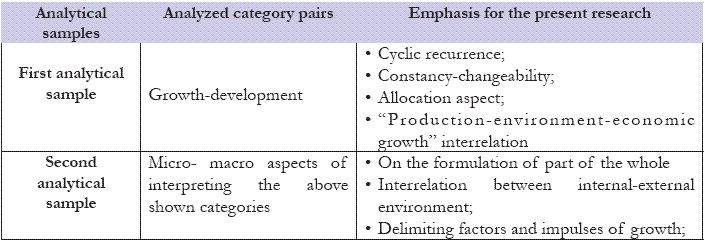
The emphasis which we borrow from this theory for carrying out further research is related to knowledge of cyclic recurrence of processes connected with the start, development and end or transformation of a certain economic activity, based on specific structural and organizational definiteness. The emphasis which we lay when including the first analytical sample in the further research relates to the fact that tourist business stability is established under the impact of social, economic and natural environments.
The second analytical sample fixes micro- and macro aspects of corporate growth category. When studying it we accept the theoretical formulation that the interaction between subjects operating on macro and micro levels within the national economy is carried out in “part-whole”, “element-system”, “function-structure” modes (1). In this sense dependence is drawn between successful operation of the national economy as a prerequisite for quality and market success of firms operating in the respective national environment. Prerequisites for multiplying the positive effect at corporate level are created through successful well-functioning economy.
2. CONFIGURATION OF THE MODEL FOR CORPORATE EXPANSION STRATEGIES COORDINATION
The structure and mechanism of functioning are attributes of every model, so identifying the components is as important as explaining their mutual commitment and interaction between them. The identification of drivers, adopted as components of the model, logically corresponds to the starting points, characterized as peculiarities of tourism business, namely:
· First: Inextricably bound elements of the chain for creating a whole and finished product – “synchronic contact” (4);
· Second: Time lag between the order and realization of the requested services (5);
· Third: Commitment between economic, social and natural factors in the production of services in the sphere of tourism (8);
· Fourth: Non-material character of the standard package of tourist services (5).
The models for carrying out tourist business change under the impact of environment and this requires the study of transformations to be carried out not only in space aspect but also in time aspect, as some of them are related to every destination within the model of mass tourism (14). The variety of forms and elements contained which interact among one another by the force of a particular economic concept give reason to delimit different business models under which in modern market environment the model of organized mass tourism has dominating significance. This fact gives us reason to call tourist business relatively independent system which functions within three different types of environment – natural, market and social environments.
Thus the effective functioning of tourism as business is directly bound to sustainable development for a number of reasons, namely:
· The functioning of tourist business is possible on the basis of tourist resources which are not only a prerequisite but are also organically related to the tourist destination (6);
· The development and functioning of tourist business creates effects for the respective region and for the local population. Observing business sustainability principles guarantees unidirectional in the interests between employers and employed, between administration and population, between investors and consumers arriving in the destination as tourists (9).
In this sense drivers should, on one hand, reflect the philosophy of tourism business, and, on the other hand – reveal the opportunities and sources of growth when a company interacts with a business environment. The configuration of the model (Figure 1) includes three steps, namely:
· Defining essential characteristics of drivers;
· Defining areas subject to coordination according to the essential characteristics of the driver;
· Defining the source and strength of impulses to provoke corporate interest.
Figure 1 - Configuration of the model for corporate growth impulses coordination
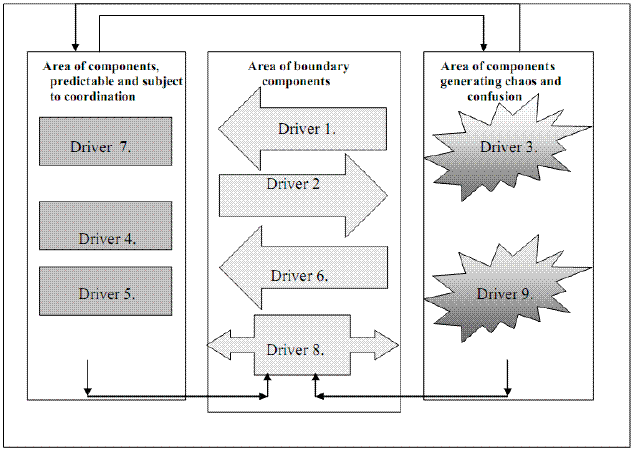
This formulation lets us fix the following drivers provoking growth, which comprise the coordination model:
Driver 1. – focusing on the interaction “production - technology”. In tourism business the essence of the interaction “production - technology” (10) is revealed through how the production of certain kinds of services is identified with the specific destination in order to create a package product of characteristic nature.
Driver 2. – “Distribution vector” is describing the interaction between supply - demand and product - product quality (3). It encompasses all formal distribution levels. Not only distribution characteristics in the sphere of tourism are described by this component, but also levels that would provoke growth are identified (4).
Driver 3. – connecting the elements: competition - competitiveness - integration. It outlines the positions of the firm among the main competitors (7), as well as the growth opportunities premised by the direct opposition between company and competitors.
Driver 4. – describing organizational structure and opportunities for restructuring, which generates growth and expansion in scale or vice versa (12).
Driver 5. – describing capital structure and market value of the firm. The driver refers to the capital resources, which guarantee the operation and development of the firm. It encompasses the possibilities to increase both assets and effectiveness of investments (1).
Driver 6. – describing the interaction “tourist business - local environment”. It is important for revealing the relation between business itself and socio-economic development of the region, where the tourist destination is (15).
Driver 7. – it gives information about the external agents, involved in tourism (from the public and private sectors) and above all about governmental and public bodies (19), which carry out a certain policy ensuring interdisciplinary approach in regulating problems (20) on a macro level.
Driver 8. – other external agents, directly connected to tourism business. The driver encompasses the effects, which tourism generates to the other branches of economy (2).
Driver 9. – agents and phenomena generating confusion (chaos) in the system. They are connected to such events and phenomena whose strength of manifestation most often is not subject to regulation (13).
The essential characteristics of the separate drivers complete the first step in configuring the growth impulses coordination model.
The second step in configuring the model of corporate growth strategies coordination is connected to the defining of areas in which we arrange the listed drivers depending on to what extent they are subject to coordination (16). According to their essential characteristics we form three areas:
· area subject to coordination,
· area not subject to coordination and
· boundary area.
Which of these three areas the respective driver will be referred to, as a model component, depends on to what extent the relations and connections, which are described by it, are transparent and emit signals of predictability and in this sense, are subject to management (Table 3).
Table 3 - Components in generating corporate growth
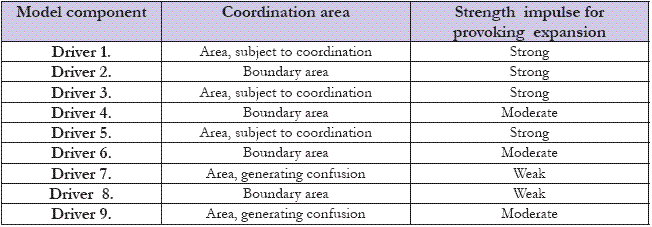
The third step in configuring the growth impulses coordination model is connected to the necessary condition for indicating one. Indicating corporate growth is done by specific indicators (Table 4).
Table 4 - Indicators and variables for establishing corporate growth
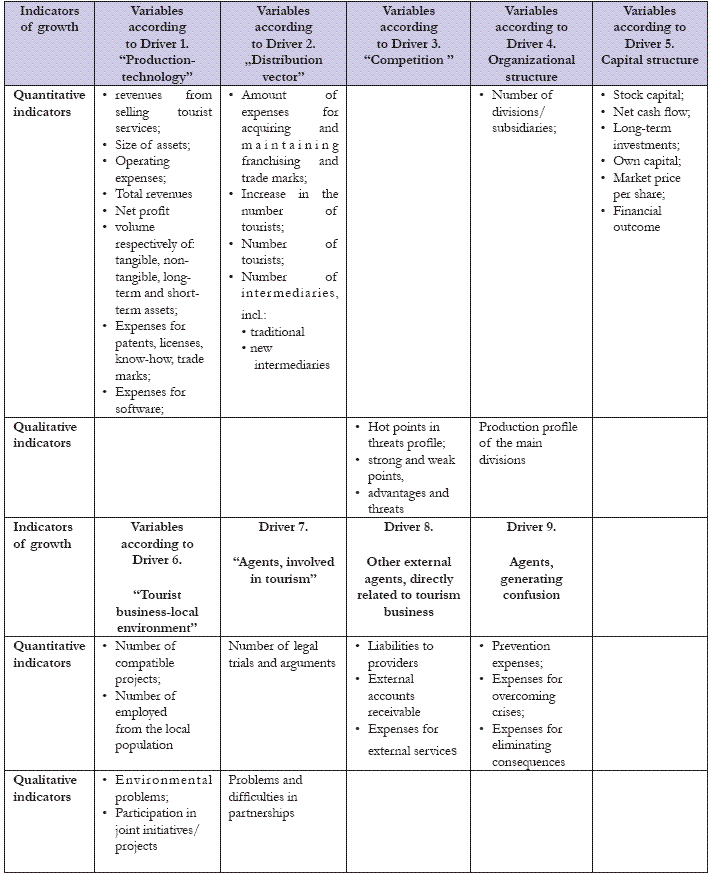
We define them based on whether there is correlation dependence between the observed indicators the separate drivers are identified with. The fixed dependence is the basis on which we differentiate the strength of impulse. We group the drivers under which the correlation dependence generating growth is fixed as follows:
· Group “А” – drivers, emitting strong impulses for provoking growth;
· Group “B” – drivers, emitting weak impulses for provoking growth;
· Group “C” – drivers, emitting moderately strong impulses for provoking growth.
The possible sources of growth will be confirmed according to the specified drivers for separate firms as a result of a survey with Bulgarian tourist firms from the Black sea region. The configuration of the model for corporate growth impulses coordination is completed according to the formulation of the components character, the possibilities for their coordination and the strength of impulses provoking sustainable corporate growth.
3. INDICATING GROWTH IN FIRMS IN THE SPHERE OF BULGARIAN TOURISM
A necessary condition for identifying the corporate growth sustainability is its registration. The research for indicating corporate growth is based on a survey, carried out with the help of two branch organizations important for Bulgarian tourism business. For testing of the model for corporate growth the Association of Bulgarian Tour Operators and Tourist Agents as well as the Bulgarian Hotel and Restaurant Association recommended that their members participate in the survey. As a result of this to 185 questionnaires emailed there was a return of 34% registered. The survey includes collected data from the period 2007-2008 regarding the inquiry target. The period of the approbation of the model in the praxis is relatively short and the number of the surveyed firms – mainly from the region of Bulgarian Black Sea coast - is limited. This makes the results of the survey important for the present development of tourism business in Bulgaria, because the Black Sea coast is one of the main recreation and tourism areas in Bulgaria.
The construction of the inquiry self contents two parts – the first one gathers information which helps to prepare the general profile of the surveyed firms, and the second part focuses on the character, elements, sources and forms for realizing and measuring corporate growth.
The main purpose of the inquiry is to collect information about the types and sources of corporate growth in tourism business using quantitative and qualitative measures. It happen whit the help of the indicators and variables, classified in Table 3. The data from the first part of the survey, which gathers general information about the participants, forms the cognitive profile of the surveyed firms (Figure 2).
Figure 2. Character, sources, manifestation and ways of measuring corporate growth
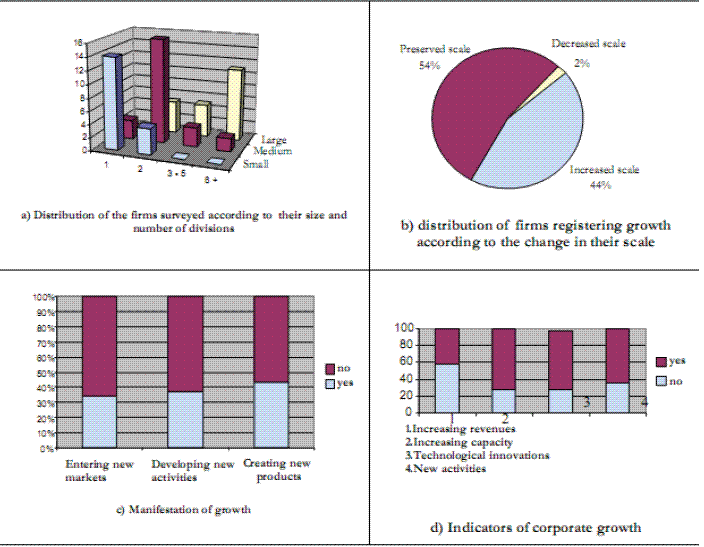
It shows that:
· 42% of the surveyed carry out mainly tour operator or agent’s activities, and 57% - hotel and restaurant management;
· 67% of the surveyed are Bulgarian firms, 15% are foreign and 17% are mixed firms of the JV type, but they all operate mainly on the Bulgarian tourist market;
· according to the ownership and type of registration the firms that prevail are limited liability companies - 39%; 29% are sole traders; and 23% are public limited companies;
· according to the duration of existence 37% of the surveyed firms were founded more than ten years ago; 28% have been operating for up to five years; and 20% - for up to two years;
· according to the scale 38% of the surveyed firms define themselves as medium-size firms; 33% - as large-size firms and 28% - as small-size firms;
· there is an additional question, checking the validity of information, about the number of divisions, according to which over 39% of the surveyed have at least two divisions, 26% - only one, 20% - six and more and 14% - between three and five divisions.
The second part of the structured survey divides information into two trends:
· character, sources, forms of manifestation and ways of measuring corporate growth;
· studying the conditions for corporate sustainable growth when interacting with environment.
3.1. COORDINATION OF THE GROWTH IMPULSES FOR THE DRIVERS, EMITTING STRONG IMPULSES FOR PROVOKING GROWTH
The questions structured according to the first driver aim to focus on the interaction “production - technology”. Information about it is obtained through the questions of this block of the survey:
· whether there is growth in the firm,
· whether it is intensive or extensive,
· what the indications of growth are,
· what the preferred way for measuring it is,
· what its manifestations are.
The information obtained gives the following picture about the condition of corporate growth of surveyed firms in Bulgaria. Throughout the whole period 2003-2008 only twelve of the firms surveyed did not register any growth.
Regarding statistical observation for the period 2000-2008 the firms registered the weakest growth in 2003/2004 and in 2007/2008 (17). In 44% of the firms the growth is accompanied with an increase in resources, respectively with an increase in scale (Figure 2, b) which is qualified as extensive growth. In the prevailing part of the surveyed, however, growth is realized preserving the scale – 54%, which can be defined as intensive growth. In 38% of the cases the displayed growth is related to entering new markets, in 37% - to entering new production activities, and in 43% - to creating new products (Figure 2, c). A combination of these three is observed in a significant part of the surveyed firms.
Indications of the realization of corporate growth are the increased revenues from the main activity (Figure 2, d). The data show that 57.8% of the firms accept the increase in revenues as an indicator of growth. A limited number of the surveyed firms accept the increase in capacity, technological innovations or including new activities as indicators of growth. Therefore, they connect corporate growth directly to the increase in production output. For this reason revenues are used as indicators of growth in 59.4% of the firms, and the increase in profit – in 46.9%. Only 34% of the firms connect growth to the increase in assets and 31% - to the increase in investments in innovations. When analyzing the mutual commitment between ‘changes in scale’ and ‘manifestations of growth’ we can observe dependence between ‘entering new markets’ and ‘change in scale’ of the firm. In ‘entering new production activities’ and in ‘creating new products’ no such dependence is observed. At the same time following the behavior for ‘entering new markets’ there is an increase in the scale of the firm, which accounts for the existence of well expressed, statistically significant moderate dependence with a correlation coefficient of 0.524. Therefore, we can presume that the entering of new markets is accompanied with building new divisions, and this leads to an increase in scale. There is dependence between ‘the change in scale’ and ‘the volume of revenues from main activity’. The correlation coefficient amounts to 0.598, which defines it as statistically significant, despite being moderate. A conclusion is drawn that the firms surveyed connect the increase in scale to the increase in revenues. The analysis of the dependence between ‘change in scale’ and ‘measuring growth’ shows moderate dependences; indicators like ‘revenues’, ‘profit’ and ‘amount of assets’ being used for the last one respectively. The correlation coefficients have a value of 0.5 for the three dependences.
The summarized results of the analysis according to Driver 1 impose the view that among the firms surveyed there is extensive growth above all things, which is identified through ‘change in scale’ and an increase in ‘volume of revenues from main activities’. The questions of the survey according to the second driver – ‘Distribution vector’ – aim to gather information, describing the interaction between supply and demand through the prism of product quality. That is why they have in mind the relations between partners and clients on all formal levels of distribution. The main way for providing quality is investing in quality corporate systems. This is what most of the firms think – 57.8%. Franchising is one of the ways for guaranteeing quality, so 35.9% of the surveyed chose it. The surveyed firms do not accept the increase of quality as an end in itself. The efforts in this direction are rooted in the desire for raising competitiveness. That is what 62.5% of the surveyed think. Satisfying clients’ needs is also a reason for guaranteeing and increasing quality. This answer was given by around 46% of the surveyed. The requirements of the distributors rank third among the options given in the survey in defining the impetus for guaranteeing quality. Hardly a fourth of the surveyed firms gave this answer.
As the third driver outlines the firm’s market positions among competitors, it is used to define possible strategies – cooperation or confrontation – which ensure the most favorable opportunities for firm’s growth and development. According to the answers of the firms surveyed their cooperation with other firms aiming to commonly confront competitors is not a preferred form of market behavior (Figure 3, a). Only 29% of the surveyed use such activities when forming market behavior. Firms doing independent activities make up almost 40%. About 30% of the surveyed firms think that they are in direct competition with the others but without any conflicts. Over half of the surveyed do not see any danger in their competitors’ activities, but the percentage of those who consider that competitors endanger their business is not low – 42.9%. About 48% of the firms see in their competitors a stimulus for their own development, a little more than half of them – 51.6% do not consider that competitive environment stimulates development (Figure 3, b).
Figure 3. Competition – factor for stimulating corporate growth

The check for a correlation relation between the firms’ registered growth, its form of manifestation and the impact of competition does not show any presence of statistically significant dependence.
The fifth driver is connected to the firm’s capital assets and investment portfolio. That is why the questions in the survey related to the character of this driver affect capital resources which guarantee the firm’s operation and development. The survey makes it clear that firms which rely on their own investment resources for their development – 41%, and firms which turn to restructuring within their present scale – 39.7% enjoy almost equal share allotment (Figure 4, c). Less than one fifth (about 19% of the firms) intend to acquire shares from other firms and thus to realize growth (Figure 4, b). The answers given make us think that firms do not rely on capital and financial market as a source of development resources; therefore they use their own investment resources for development and restructuring.
Figure 4. Organizational and capital structure
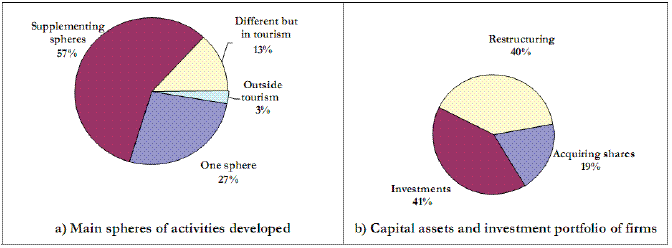
3.2.COORDINATION OF THE GROWTH IMPULSES FOR THE DRIVERS, EMITTING MODERATELY STRONG AND WEAK IMPULSES FOR PROVOKING GROWTH
The questions of the survey related to the fourth driver are connected with the firm’s organizational structure and the opportunity for its optimization, assuming that every organizational unit is specialized in a certain kind of activity. At the same time answers are sought to the question whether the rise in activities diversification leads to corporate growth, including to an increase in the number of corporate business units. According to the answers given the main activity of over 96% of the firms falls into the tourism business range (Figure 4, a); 27% of them report operating in one sphere only. 57% of the firms report more than two activities, which supplement the main one, and only 3% of the firms surveyed report that these supplementary activities are outside tourism business. When checking for a correlation relation between the changes in the firm’s scale which traces its growth and the number of activities developed, as an indicator of the organizational structure, no statistically significant dependence is observed. The data analysis shows that there is a low degree of activities diversification in the firms surveyed.
While the sixth driver is important for revealing the relation between business and socio-economic development of the region, within which range the tourist destination falls, the seventh driver contributes to revealing the relation between firms in tourism and those governmental and public bodies which form and carry out a policy for development and regulation of business. For this reason the survey questions related to the specified drivers aim to find out whether there are favourable conditions for the tourism business development, whether “business environment” for tourism can be improved in some way, what governmental bodies do to aid firms’ activity and what local authorities do to aid business (Figure 5, a).
Figure 5. Interaction “tourist business-local environment” and “tourist business-macro environment”
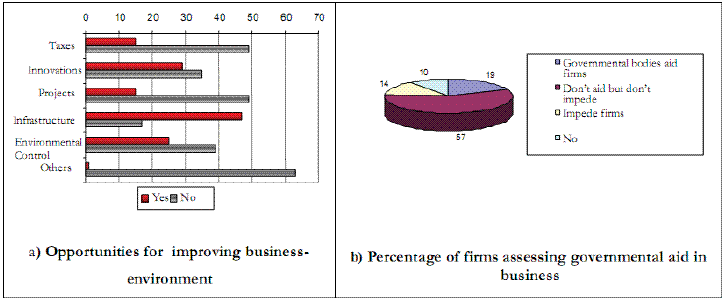
Assessing the work of the governmental bodies, more than half of the surveyed firms are of the opinion that government does not impede their business but at the same time does not support it – 56.5%, and every sixth firm thinks that government rather impedes their business development (Figure 5, b).
The situation with the local authorities is analogous. Again with the highest relative percentage are the answers that local authorities do not aid firms in the tourist branch – 43.3%. The conclusion is that the registered assessment by the surveyed firms about the interaction between governmental bodies and firms is indicative of the existence of accumulated unsolved problems, which makes business accept the attitude that something may change.
When looking for correlation dependence between corporate growth (measured by gained profit) and improvement of tourism business environment (by means of stricter environment control) such is found. The dependence is moderate, positive and statistically significant both at 5% and 1% risk of error. The correlation coefficient is 0.339. There is still other dependence – between corporate growth and innovations. It is moderate, positive and explains the firms’ expectations for improvement in business environment as a consequence of the stimuli of macro level for innovations. That is why almost 75% of the surveyed firms in which growth is related to innovations, report that business environment in the sphere of tourism could be improved if the governmental bodies stimulate more eagerly innovation processes. In firms which do not relate growth to innovations it is vice versa – 66.7% do not see any chance for the environment to be improved in this aspect.
As a consequence of the three found correlation dependences we can conclude that more and more firms realize the fact that it is possible to make a profit if environmental standards are observed and stimuli are created to invest in innovations and environmental initiatives. So their expectations for improvement of business environment follow this trend (18).
According to the contents of the eighth and ninth drivers in the structure of the model for coordinating corporate expansion strategies, through them is traced the impact of external agents and factors for tourism business in two trends:
· the firms’ reaction owing to disrupted environmental equilibrium;
· positive and negative influences upon corporate business in the sphere of tourism owing to Bulgaria’s real EU membership.
The results of the survey show that in a larger part of the firms that answered the questions – 58.7%, environmental pollution influences business, but the percentage of those that answered negatively is not small – 41.3%, which makes the opinions almost equivalently polarized. The conclusion is that there is not an expressed attitude for the existence of a realized risk of environmental pollution on tourism business in our country.
According to the outcome of the survey Bulgaria’s EU membership undoubtedly influences tourism business firms. Over 90% of the surveyed answer that it has a positive influence and only 2% answer negatively. The positive influence of our country’s EU membership is directed to eliminating boundary restrictions and increasing the number of people traveling to and from the EU Member States. Only in this case the positive answers – 70.3% - exceed the negative answers – 29.7%. Firms do not think that there is a positive influence as regards the increase in control along the external boundary of EU and the preserving of safety related to it as well as the increase in the appeal of Bulgarian tourism business for foreign investments but it is expressed less strongly.
The negative influence of our full EU membership is related above all to limiting the number of tourists arriving from outside EU (Russia, Ukraine, Macedonia and Serbia). Nearly 59.4% of the surveyed indicate this threat as real. Firms’ reaction regarding positive and negative influences of EU membership is explainable, as EU market and those of Eastern Europe are equally important as emittents for Bulgarian tourism business.
When looking for correlation dependences between the researched aspects of external agents and factors for tourism business and the aspects of corporate growth we find out that there is dependence between eliminating formalities of movement owing to our EU membership and the change in the scale of firms examined as a sign of corporate growth.
The dependence is significant at 5% of risk. There is moderate correlation of 0.384. The percentage of firms, recording positive influence, is higher with the increased scale and lower – at the preserved scale. That is why we can claim that in companies that have increased their scale the influence of the free movement owing to our EU membership is more explicit. Therefore the scales of expanding of firms are influenced by the potential number of tourists as well as of the real number of the received tourists which determines the consequences of our EU membership as a factor of growth.
The research carried out leads to the following conclusions:
· The survey carried out relies on information and attitudes reflecting the position and state of the surveyed tourist firms, through the eyes of the firms themselves and their managers. Including indexes based on qualitative indicators aims at not only the more precise but also the objective recording of the firms’ state and generating economic growth. As far as this growth is a prerequisite for sustainable growth, the data show the opportunities and attitudes in the different firms about what is really premised by the success of their operation when interacting with business environment.
· The synthesis on the results of the survey makes us conclude that growth impulses which move the different firms are, above all, related to the firm’s potential (opportunities for increasing revenues, respectively profit through increasing capacity), after which come market factors as consumer demand and the level of quality connected to it or factors as competitive confrontation.
· The fact about the complex character of a tourist product and the narrow commitment of tourist activities is still not realized. To a great extent this is realized by the more diversified tourist firms, which carry out different, but interrelated activities such as accommodation, transport, tour operation or tour agency. The stated above explains the fact that a small part of the surveyed look for forms of cooperation and collaboration but pursue independent success, materialized in gaining higher profit or expanding the scale of the inventory.
· A larger part of the surveyed firms have not given significance to the idea of achieving sustainable growth as an interaction between the firm and business environment in which to form favorable relations with institutions – local and governmental.
· The surveyed firms connect the problems of sustainable development most often with the problems of environmentally-friendly operation of tourist sites and not with the opportunities for making profit for the business by combining firm’s interests with social and collective interests.
BIBLIOGRAPHICAL REFERENCES
Albach, H., (1999): Zur Theorie des Unternehmungswchstums, VSA Verlag, Hamburg. [ Links ]
Bellinger, M., (1999): Unternehmenskrisen-Unternehmenswachstun, Springer Verlag, Berlin.
Buchele, H., (1997): Growing Firms, W.W. Norton &Company, N.Y./London.
Bosselman, F. et al. (2005): Managing Tourism Growth: issues and applications, Washington DC: Island Press.
Cooper, C.; J. Fletcher (1993): Tourism - Principles and Practice, Pitman Publishing, London.
Dwyer, L. Kim, C., (2003): “Destination Competitiveness: Determinants and Indicators”, Current Issues in Tourism, 6 (5), 369-414.
Ehlermann, C. (1992) Competitive Analysis of Central and Eastern Europe, Pinter Publishers, London.
Gechev, R. (2005): Sustainable Development, University of Indianapolis Press, Indianopolis, p. 98.
Johnston, R., Tyrrel, T. (2005) “A Dynamic Model of Sustainable Tourism”, Journal of Travel Research, vol. 44, nº 2.
Kirstges, T., (1999): Expansionsstrategien - Marktanalyse und Strategiebausteine, Gabler Verlag, München-Köln.
“Kondratiev cycles” in: http://www.gold-eagle.com/editorials_01/alexander051401pv.html, “The Kondratiev Cycle and Secular Market Trends”, in Irrational Exuberance, latest state, February 2005.
Kueting, E. (2001): Wachstumspolitik und Wettbewerb, Verlag Münster Universität, Münster.
Laurencie, J-P. (1993) European Perspective on Development of Competition in Transition, Pitmann Publ. London.
---“Mass standardized and rigidly packed tourism – MSRT” in: Turner, R., Pears, D. W., Bateman, I. (1994): Environmental Economics: An Elementary Introduction, Harvester Wheatsheaf, Hemel Hempstead, P. 137.
Matheson, A., Wall, G. (1995): Tourism: Economic and Social Impacts; Longman, London.
Megginson, W.; J. Netter, (2001): “From State to Market: A Survey of Empirical Studies”, Journal of Economic Literature, Vol. 39 (2).
---“Support for raising competitiveness of Bulgarian enterprises”, procedure for granting gratuitous financial help under the PHARE project: BG2006/018-164.05.01 Source: http://www.iaphare.org/bg/project/project.php?id=2512
Rakadjiska, S.G., (2003): “The Transition of Bulgarian Tourist Industry to Market Economy”, in: Problems and Prospects of Cooperation between the Countries of South-Eastern Europe, Collection of Scientific Works, Donetsk-Svishtov-Albena.
Stankova, M. (2004): Redefining the tourism as a factor for sustainable development, Balkan-Ecology, 2, Sofia.
Torsten, ., (1999) Expansionsstrategien - Marktanalyse und Strategiebausteine, Gabler Verlag, München-Köln.
WEBSITES
http://www.tourism.government.bg/bg/stat.php?menuid=3&id=13
Recebido: 15.07.2009 - Aceite: 10.12.2009













